土的压缩性及固结理论
- 格式:doc
- 大小:377.00 KB
- 文档页数:11
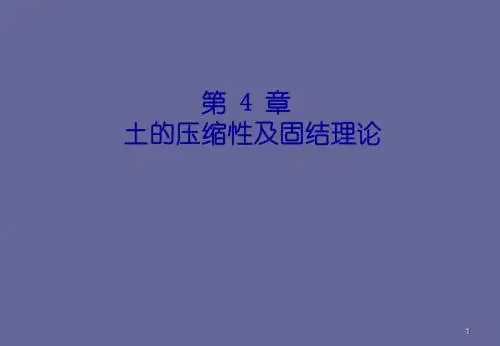
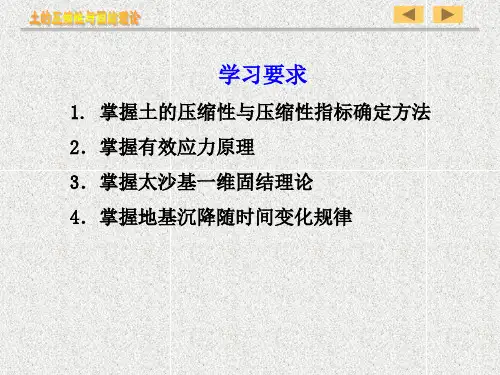
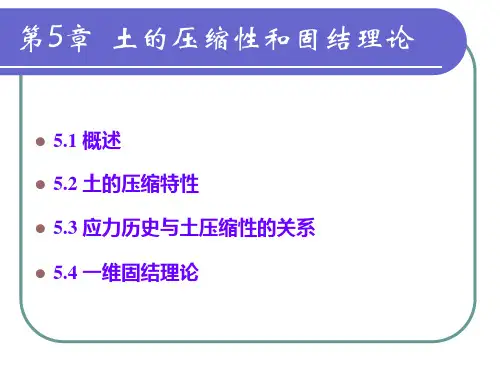
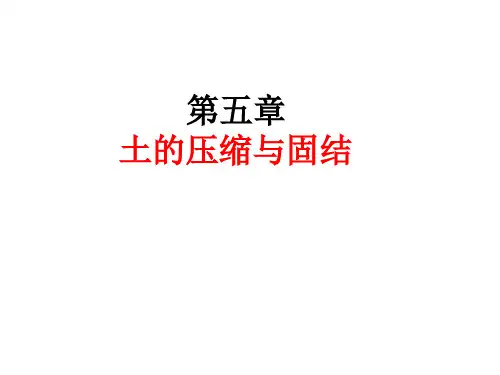

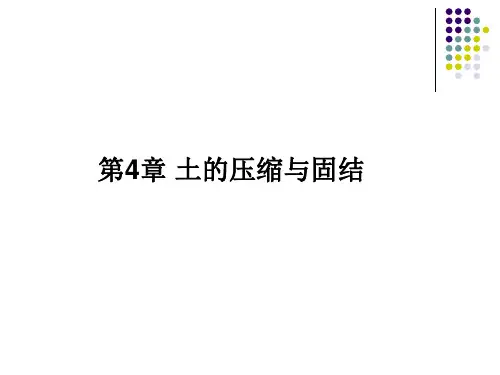
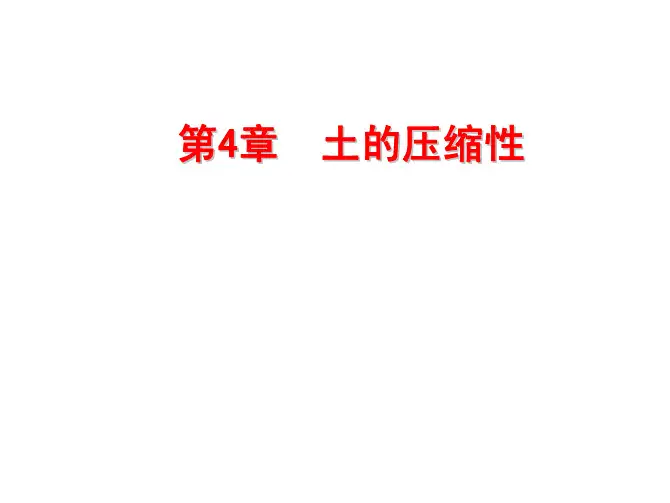
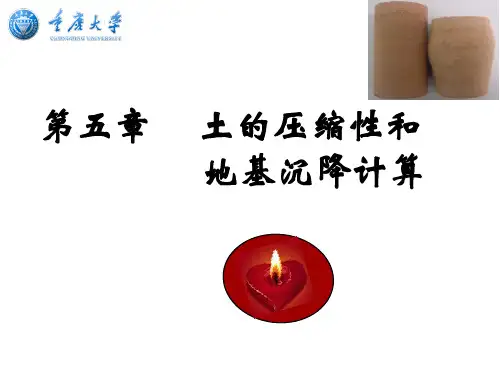
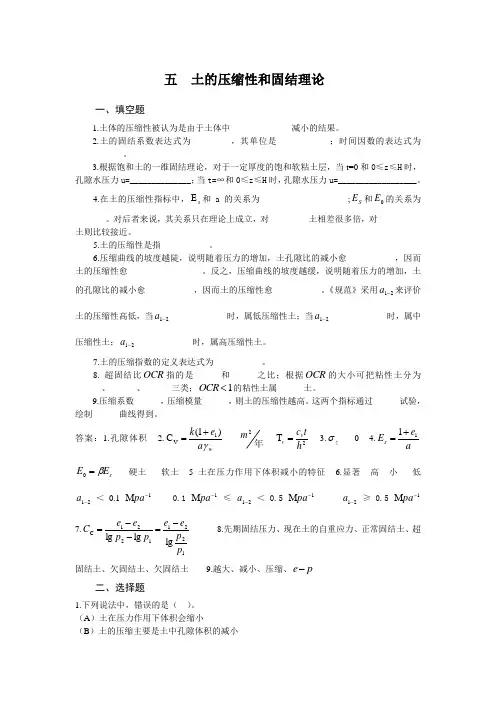
五 土的压缩性和固结理论一、填空题1.土体的压缩性被认为是由于土体中______________减小的结果。
2.土的固结系数表达式为_________,其单位是____________;时间因数的表达式为___________。
3.根据饱和土的一维固结理论,对于一定厚度的饱和软粘土层,当t=0和0≤z ≤H 时,孔隙水压力u=______________;当t=∞和0≤z ≤H 时,孔隙水压力u=__________________。
4.在土的压缩性指标中,s E 和a 的关系为____________________;S E 和0E 的关系为_______。
对后者来说,其关系只在理论上成立,对_________土相差很多倍,对__________土则比较接近。
5.土的压缩性是指___________。
6.压缩曲线的坡度越陡,说明随着压力的增加,土孔隙比的减小愈___________,因而土的压缩性愈_________________。
反之,压缩曲线的坡度越缓,说明随着压力的增加,土的孔隙比的减小愈___________,因而土的压缩性愈___________。
《规范》采用21-a 来评价土的压缩性高低,当21-a _____________时,属低压缩性土;当21-a _____________时,属中压缩性土;21-a _____________时,属高压缩性土。
7.土的压缩指数的定义表达式为___________。
8. 超固结比OCR 指的是______和______之比;根据OCR 的大小可把粘性土分为______、______、______三类;1OCR <的粘性土属______土。
9.压缩系数______,压缩模量______,则土的压缩性越高。
这两个指标通过______试验,绘制______曲线得到。
答案:1.孔隙体积 2.wa e k γ)1(C 1V += 年2m 2T h t c vv = 3.z σ 0 4.a e E s 11+= s E E β=0 硬土 软土 5土在压力作用下体积减小的特征 6.显著 高 小 低 21-a <0.11M -pa 0.11M -pa ≤21-a <0.51M -pa 21-a ≥0.51M -pa 7.12211221C lg lg lg p p e e p p e e C -=--= 8.先期固结压力、现在土的自重应力、正常固结土、超固结土、欠固结土、欠固结土 9.越大、减小、压缩、e p -二、选择题1.下列说法中,错误的是( )。
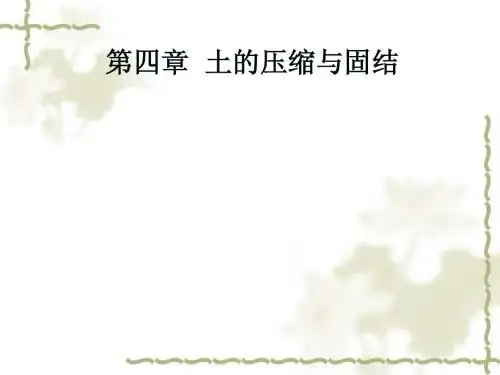

土的压缩性5.1概述土体压缩性——土在压力(附加应力或自重应力)作用下体积缩小的特性。
土体压缩包括:(1)土粒本身和孔隙水的压缩; (2)孔隙气体的压缩;(3)孔隙水、气排出,使得孔隙体积减小。
上面(1)的压缩不到压缩量的1/400,忽略;(2)的压缩量也很小,忽略。
地基土的压缩实质土的固结——土体在压力作用下其压缩量随时间增长的过程。
土体的压缩性指标:压缩系数、压缩模量。
压缩性指标测定方法:(1)室内试验测定,如侧限条件的固结试验;(2)原位测试测定,如现场[静]载荷试验。
5.2固结试验及压缩性指标 一、固结试验及压缩性指标 1.压缩试验和压缩曲线减少。
会被压缩,也会被排出部分);)不变;但会被排出(孔隙水体积(不变;土粒体积(v as V V V V ⎪⎭⎪⎬⎫⎪⎩⎪⎨⎧ω)a s E(1)侧限压缩试验(固结试验)侧限——限制土样侧向变形,土样只能发生竖向压缩变形。
通过金属环刀来实现。
试验目的——研究测定试样在侧限与轴向排水条件下的变形和压力,或孔隙比和压力的关系,变形和时间的关系,以便计算土的各项压缩指标。
试验设备——固结仪(压缩仪)。
试验方法:逐级加压固结,以便测定各级压力作用下土样压缩稳定后的孔隙比。
(2)e -p 曲线要绘制e -p 曲线,就必须求出各级压力作用下的孔隙比。
如何求?看示意图:设试样截面积为A ,如图:依侧限压缩试验原理可知:土样压缩前后试样截面积A 不变,土粒体积不变,令,有或——分别为土粒比重、土样的初始含水量和初始密度。
利用上式计算各级荷载作用下达到的稳定孔隙比,可绘制如i p i e i p i e i e s V 1=sV iii i i i e H H e H e H e A H e A H +∆-=+=+⇒⎭⎬⎫+=+=1111100000)1(1000000e H H e e e e e H H ii i i +∆-=⇒+-=∆1)1(000-+=ρρωws G e 00ρω、、s G i p i e下图所示的e -p 曲线,该曲线亦被称为压缩曲线。
土体的变形第一部分 影响因素一. 土的压缩性1.定义:土在压力作用下体积缩小的特性称为土的压缩性。
土的压缩——土中孔隙体积的减少,在这一过程中,颗粒间产生相对移动,重新排列并互相挤紧,同时,土中一部分孔隙水和气体被挤出。
土体完成压缩过程所需的时间与土的透水性有很大的关系。
土的固结——土的压缩随时间增长的过程,称为土的固结。
2.土的侧限压缩试验:不允许土样产生侧向变形(侧限条件)的室内压缩试验3.侧限条件:侧向限制不能变形,只有竖向单向压缩的条件。
侧限条件的适用性:自然界广阔土层上作用着大面积均布荷载的情况;土体的天然土的自重应力作用下的压缩性。
4.侧限压缩试验的方法:试验方法:加荷载,让土样在50、100、200和400kpa 压力作用下只可能发生竖向压缩,而无侧向变形。
测定各级压力作用下土样高度的稳定值,即压缩量。
将压缩量换算成每级荷载后土样的孔隙比e 。
则可整理的压缩试验的结果,压缩曲线e-p 、e-logp 。
)1(000e H s e e +-=5.侧限压缩性指标压缩系数——e-p 曲线上任一点的切线斜率a ,即 dp de a -= 物理意义:压缩系数a 越大,曲线愈陡,说明随着压力的增加,土孔隙比的减小愈显著,因而土的压缩性愈高。
为了便于应用和比较,通常采用压力间隔由p 1=100kpa 增加到p 2=200kpa 时所得的压缩系数a 1-2来评定土的压缩性如下:当 a 1-2 < 0.1Mpa -1时,属于低压缩性土0. 1≤a 1-2 < 0.5Mpa -1时,属于中压缩性土a 1-2 ≥ 0.5Mpa -1时,属于高压缩性土。
压缩指数——土的e-p 线改绘成半对教压缩曲线e-logp 曲线时,它的后段接近直线,其斜率Cc 称为土的压缩指数。
同压缩系数a 一样,压缩指数Cc 值越大,土的压缩性越高压缩模量(侧限压缩模量)——土在完全侧限条件下的竖向附加压应力σz 与相应的应变εz 之比值。
第4章土的压缩性及固结理论基本内容这是本课程的重点。
在学习土的压缩性指标确定方法的基础上,掌握地基最终沉降量计算原理和地基固结问题的分析计算方法。
学习要求:1. 掌握土的压缩性与压缩性指标确定方法;2.掌握有效应力原理;3.掌握太沙基一维固结理论;4.1 概述(outline)土在自重应力或附加应力作用下,地基土要产生附加变形,包括体积变形和形状变形。
对于土来说,体积变形通常表现为体积缩小。
我们把这种在外力作用下土体积缩小得特性称为土的压缩性(compressibility)。
It is well recognized that the deformations will be induced in ground soil under self-weight or net contact pressure. The load-induced soil deformations can be divided into volumetric deformation and deviatoric deformation (namely, angular distortion or deformation in shape). The volumetric deformation is mainly caused by the normal stress, which compact the soil, resulting in soil contraction instead of soil failure. The deviatoric deformation is caused by the shear stress. When the shear stress is large enough, shear failure of the soil will be induced and soil deformation will develop continuously. Usually shear failure over a large area is not allowed to happen in the ground.土的压缩性主要有两个特点:(1)土的压缩性主要是由于孔隙体积减少而引起的;(2)由于孔隙水的排出而引起的压缩对于饱和粘土来说需要时间,将土的压缩随时间增长的过程称为土的固结。
在建筑物荷载作用下,地基土主要由于压缩而引起的竖直方向的位移称为沉降。
研究建筑物沉降包含两方面的内容:一是绝对沉降量的大小,亦即最终沉降;二是沉降与时间的关系,主要介绍太沙基的一维固结理论土体产生体积缩小的原因:(1)固体颗粒的压缩;(2)孔隙水和孔隙气体的压缩,孔隙气体的溶解;孔隙水和孔隙气体的排出。
由于纯水的弹模约为2×106kPa,固体颗粒的弹模为9×l 07kPa,土粒本身和孔隙中水的压缩量,在工程压力(100~600kPa)范围内,不到土体总压缩量的1/400,因此常可略不计。
所以,土体压缩主要来自孔隙水和土中孔隙气体的排出。
孔隙中水和气体向外排出要有一个时间过程。
因此土的压缩亦要一段时间才能完成。
把这一与时间有关的压缩过程称为固结。
土体的变形计算,需要取得土的压缩性指标,可以通过室内侧限压缩试验和现场原位试验得到。
室内压缩试验亦称固结试验,是研究土压缩性最基本的方法。
现场载荷试验是在工程现场通过千斤顶逐级对置于地基土上的载荷板施加荷载,观测记录沉降随时间的发展以及稳定时的沉降量s,并绘制成p-s曲线,即获得地基土载荷试验的结果。
反映土的压缩性的指标主要有压缩系数、压缩模量、压缩指数和变形模量。
土的压缩性的高低,常用压缩性指标定量表示,压缩性指标,通常由工程地质勘察取天然结构的原状土样进行. Characteristic of soil compression(1)Compression of soil is mainly due to the decrease of void volume.(2)The compression for a clay increases with the times (consolidation)Ground soil will deform vertically due to structure load. The contents on studying structure settlement include1 The absolute settlement (final settlement)2 Relationship between settlement and time. Introducing terzaghi’s 1D consolidation theory Reasons of volumetric reduction of soil mass1 The compressive deformation of the soil particles.2 The compressive deformation of the pore water and air. The partial discharge of the pore water and air.The consolidation process of saturated soils is in effect a process of discharge of the pore water and corresponding reduction of the pore volume. For saturated sands, pore water is apt to discharge under pressure due to high permeability; hence the consolidation process completes in a short length of time. For saturated clays, pore water discharges slowly under pressure due to low permeability; hence the consolidation process completes in a long length of time.To calculate the deformation of the soil mass, it is necessary to know the compression indexes. These indexes can be obtained from laboratory compression test (consolidation test) and field load tests.4.2 土的压缩性(soil compressibility charateristic)4.2.1 固结试验及压缩性指标(Oedometer test, Consolidation test and Compression indexes) 侧限压缩试验亦称固结试验。
所谓侧限就是使土样在竖向压力作用下只能发生竖向变形,而无侧向变形。
室内压缩试验采用的试验装置为压缩仪或固结仪(参照图4-1)。
试验时将切有土样的环刀置于刚性护环中,由于金属环刀及刚性护环的限制,使得土样在竖向压力作用下只能发生竖向变形,而无侧向变形。
在土样上下放置的透水石是土样受压后排出孔隙水的两个界面。
压缩过程中竖向压力通过刚性板施加给土样,土样产生的压缩量可通过百分表量测。
常规压缩试验通过逐级加荷进行试验,常用的分级加荷量p为:50kPa,100kPa,200kPa,300kPa,400kPa。
Compression test with zero lateral strain is also called Oedometer test. In test, there is vertical deformation but no lateral deformation under vertical load.The characteristic of a soil during one-dimensional compression can be determined by means of the oedometer test (see Fig.4-1). The test specimen (2 cm high and a diameter to height ratio of 2.5) is in the form of a disc, held inside a metal ring and lying between two porous stones. The upper porous stone, which can move inside the ring with a small clearance, is fixed below a metal loading cap through which pressure can be applied to the specimen. The whole assembly sits in an open cell of water to which the pore water in the specimen has free access. The ring confining the specimen may be either fixed (clamped to the body of the cell) or floating (being free to move vertically): the inside of the ring should have a smooth polished surface to reduce side friction. The confining ring imposes a condition of zero lateral strain on the specimen, the ratio of lateral to vertical effective stress being K0, the coefficient of lateral earth pressure at rest. The compression of the specimen under pressure is measured by means of a dial gauge operating on the loading cap. Usually the specimen is gradually loaded, and the load grades are often set as p=50kPa,100kPa,200kPa,300kPa, 400kPa。